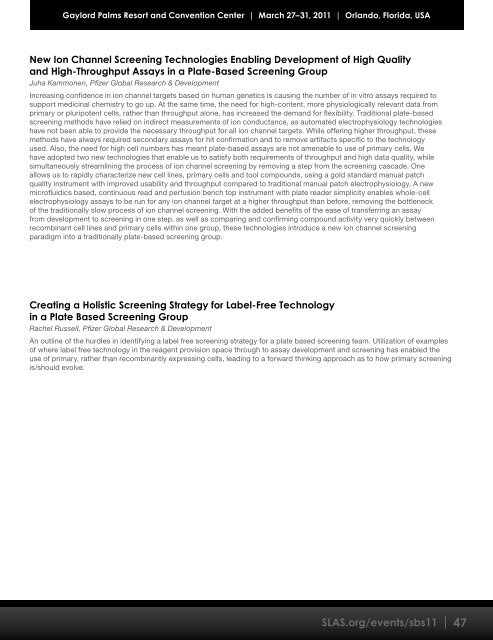Create successful ePaper yourself
Turn your PDF publications into a flip-book with our unique Google optimized e-Paper software.
Gaylord Palms Resort and Convention Center | March 27–31, <strong>2011</strong> | Orlando, Florida, USA<br />
New Ion Channel Screening Technologies Enabling Development of High Quality<br />
and High-Throughput Assays in a Plate-Based Screening Group<br />
Juha Kammonen, Pfizer Global Research & Development<br />
Increasing confidence in ion channel targets based on human genetics is causing the number of in vitro assays required <strong>to</strong><br />
support medicinal chemistry <strong>to</strong> go up. At the same time, the need for high-content, more physiologically relevant data from<br />
primary or pluripotent cells, rather than throughput alone, has increased the demand for flexibility. Traditional plate-based<br />
screening methods have relied on indirect measurements of ion conductance, as au<strong>to</strong>mated electrophysiology technologies<br />
have not been able <strong>to</strong> provide the necessary throughput for all ion channel targets. While offering higher throughput, these<br />
methods have always required secondary assays for hit confirmation and <strong>to</strong> remove artifacts specific <strong>to</strong> the technology<br />
used. Also, the need for high cell numbers has meant plate-based assays are not amenable <strong>to</strong> use of primary cells. We<br />
have adopted two new technologies that enable us <strong>to</strong> satisfy both requirements of throughput and high data quality, while<br />
simultaneously streamlining the process of ion channel screening by removing a step from the screening cascade. One<br />
allows us <strong>to</strong> rapidly characterize new cell lines, primary cells and <strong>to</strong>ol compounds, using a gold standard manual patch<br />
quality instrument with improved usability and throughput compared <strong>to</strong> traditional manual patch electrophysiology. A new<br />
microfluidics based, continuous read and perfusion bench <strong>to</strong>p instrument with plate reader simplicity enables whole-cell<br />
electrophysiology assays <strong>to</strong> be run for any ion channel target at a higher throughput than before, removing the bottleneck<br />
of the traditionally slow process of ion channel screening. With the added benefits of the ease of transferring an assay<br />
from development <strong>to</strong> screening in one step, as well as comparing and confirming compound activity very quickly between<br />
recombinant cell lines and primary cells within one group, these technologies introduce a new ion channel screening<br />
paradigm in<strong>to</strong> a traditionally plate-based screening group.<br />
Creating a Holistic Screening Strategy for Label-Free Technology<br />
in a Plate Based Screening Group<br />
Rachel Russell, Pfizer Global Research & Development<br />
An outline of the hurdles in identifying a label free screening strategy for a plate based screening team. Utilization of examples<br />
of where label free technology in the reagent provision space through <strong>to</strong> assay development and screening has enabled the<br />
use of primary, rather than recombinantly expressing cells, leading <strong>to</strong> a forward thinking approach as <strong>to</strong> how primary screening<br />
is/should evolve.<br />
<strong>SLAS</strong>.org/events/sbs11 | 47

















